集体潜意识论
- 格式:ppt
- 大小:2.11 MB
- 文档页数:20


心理学案例分析题解析之集体潜意识2011年下半年心理咨询师考试报名进行中,松鼠哥特编辑整理心理咨询师考试相关资料、试题,希望对您的考试有所帮助!5月,接受广东电视台记者采访,说着富士康的九连跳的心理动力,采访结束时打开电脑发现已经十连跳了,真快!当晚,广工一名已经签约富士康的应届毕业生不慎坠楼身亡(非自杀),真巧!员工跳楼自杀算是事件,但能在同一家公司并在5个月内发生十起,可以算作灾难了吧。
一家公司发生的,是小灾难,但在相同时间段,在同一个国家的不同地方发生,就算大灾难了。
自杀是一种极端的对自己的攻击,极端的对别人的攻击呢?短短50天,6起同一类校园凶杀案,砍死10人、砍伤76人。
这和跳楼事件难道毫无关联吗?还有,今年发生在咱们国家的矿难、旱灾、地震、水灾,这些灾难的伤亡数量远比富士康员工跳楼和校园凶杀案大得多呀!试试看,把镜头拉远一点,这一切就仿佛是同一个灾难,并且你或许还能发现这其中的联系。
如果,我们再把镜头拉远一点,看看世界范围发生的事情,也许会看得更清楚一些。
仅2010年以来,海地地震、智利地震、美国暴风雪、土耳其地震、印尼地震、台湾地震,以及排着队争先恐后的九起空难数百人丧生(印度又坠机,死158人)。
如果我说所有的这一切都是同一场灾难,你有什么看法?每一次看到这类事情的报道,我的心里都有一种难以形容的难受。
不论是天灾还是人祸,都发生在地球上、都发生在人身上、都和生存有关、都和生命有关。
都和人类有关!也许,人类不能只在每个个体里面解决问题了,甚至人类不能只在人类内部解决问题。
富士康员工跳楼和最近频繁发生的校园幼儿园凶杀案,已经不是心理学工作者所能解决、所能预防的。
这是全社会、全人类的事情了!地球上所发生的每件事,都是在对人类传递着每种信息。
打开《广州日报》头版,几乎占据整个版面的是两幅大型标题新闻。
第一条是江西火车出轨19人死,第二条是辽宁大巴被撞32人亡。
灾难已经成为各大新闻媒体的头等报道,如果那天报纸上没说地震、旱涝、火山、杀人、跳楼,那就不正常了。

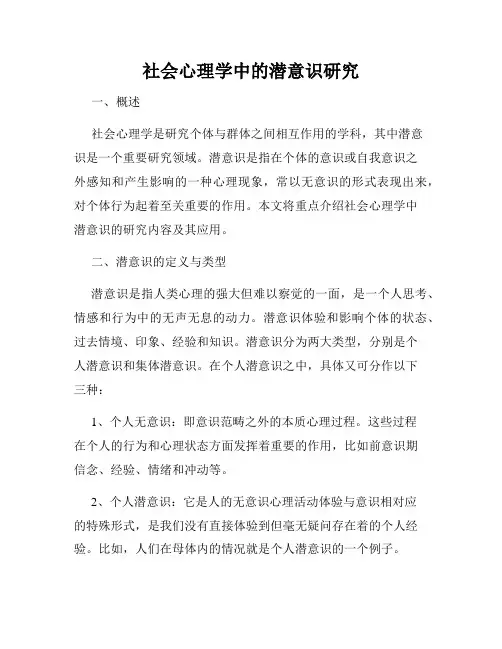
社会心理学中的潜意识研究一、概述社会心理学是研究个体与群体之间相互作用的学科,其中潜意识是一个重要研究领域。
潜意识是指在个体的意识或自我意识之外感知和产生影响的一种心理现象,常以无意识的形式表现出来,对个体行为起着至关重要的作用。
本文将重点介绍社会心理学中潜意识的研究内容及其应用。
二、潜意识的定义与类型潜意识是指人类心理的强大但难以察觉的一面,是一个人思考、情感和行为中的无声无息的动力。
潜意识体验和影响个体的状态、过去情境、印象、经验和知识。
潜意识分为两大类型,分别是个人潜意识和集体潜意识。
在个人潜意识之中,具体又可分作以下三种:1、个人无意识:即意识范畴之外的本质心理过程。
这些过程在个人的行为和心理状态方面发挥着重要的作用,比如前意识期信念、经验、情绪和冲动等。
2、个人潜意识:它是人的无意识心理活动体验与意识相对应的特殊形式,是我们没有直接体验到但毫无疑问存在着的个人经验。
比如,人们在母体内的情况就是个人潜意识的一个例子。
3、个人前意识:即那些意识还没有被完全形成、却又渐渐形成的心理活动体验。
前意识的体验能够实现成为意识的内容,但在某些情况下也会不再成为意识的存在。
三、潜意识与行为的关系潜意识的影响渗透到个体的行为中,而且也在很多情况下强于显意识的作用。
潜意识和行为之间没有必然增量关系,但是潜意识的存在是行为的必要条件,它对于个体行为与反应产生了重要的影响。
1、潜意识和行为的关系个体并不总是自主控制自己的行为和态度,潜意识在个体中占有非常重要的地位。
潜意识与行为之间的关系是通过潜意识产生影响,进而动用个体的行为和态度的方式来实现。
比如,人们在无意识中分辨出贵公司家族还是便利店还是巴克对于自己的品位有什么不同、他们自己是怎样一种人的价值、他们是否享有权力和成功等,并通过对这些信息的处理激发出更加精细的行为。
2、如何测量潜意识潜意识有时很难通过自报问卷或接受人际交往来准确测量。
使用“心理反应测试”技术,也就是受试者在做某种简单的任务时,对于某些不相关的刺激或信息做出非自我意识下的反应,从而了解其不-analog结果,能帮助研究员了解潜意识中隐藏的信息。
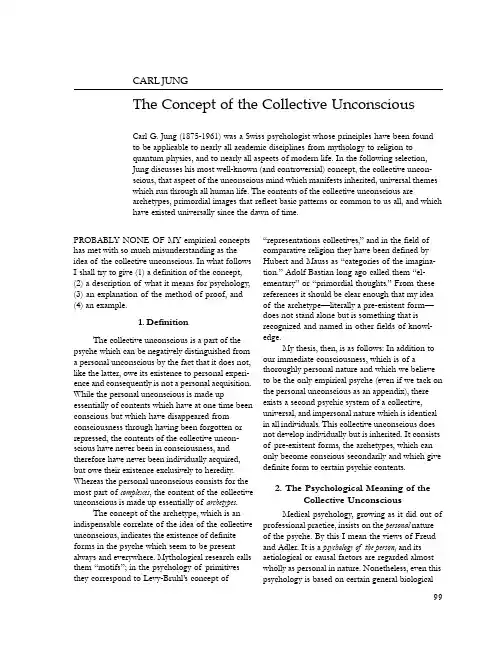
The Concept of the Collective Unconscious CARL JUNGCarl G. Jung (1875-1961) was a Swiss psychologist whose principles have been found to be applicable to nearly all academic disciplines from mythology to religion to quantum physics, and to nearly all aspects of modern life. In the following selection, Jung discusses his most well-known (and controversial) concept, the collective uncon-scious, that aspect of the unconscious mind which manifests inherited, universal themes which run through all human life. The contents of the collective unconscious are archetypes, primordial images that reflect basic patterns or common to us all, and which have existed universally since the dawn of time.PROBABLY NONE OF MY empirical concepts has met with so much misunderstanding as the idea of the collective unconscious. In what followsI shall try to give (1) a definition of the concept,(2) a description of what it means for psychology,(3) an explanation of the method of proof, and(4) an example.1. DefinitionThe collective unconscious is a part of the psyche which can be negatively distinguished from a personal unconscious by the fact that it does not, like the latter, owe its existence to personal experi-ence and consequently is not a personal acquisition. While the personal unconscious is made up essentially of contents which have at one time been conscious but which have disappeared from consciousness through having been forgotten or repressed, the contents of the collective uncon-scious have never been in consciousness, and therefore have never been individually acquired, but owe their existence exclusively to heredity. Whereas the personal unconscious consists for the most part of complexes, the content of the collective unconscious is made up essentially of archetypes.The concept of the archetype, which is an indispensable correlate of the idea of the collective unconscious, indicates the existence of definite forms in the psyche which seem to be present always and everywhere. Mythological research calls them “motifs”; in the psychology of primitives they correspond to Levy-Bruhl’s concept of “representations collectives,” and in the field of comparative religion they have been defined by Hubert and Mauss as “categories of the imagina-tion.” Adolf Bastian long ago called them “el-ementary” or “primordial thoughts.” From these references it should be clear enough that my idea of the archetype—literally a pre-existent form—does not stand alone but is something that is recognized and named in other fields of knowl-edge.My thesis, then, is as follows: In addition to our immediate consciousness, which is of a thoroughly personal nature and which we believe to be the only empirical psyche (even if we tack on the personal unconscious as an appendix), there exists a second psychic system of a collective, universal, and impersonal nature which is identical in all individuals. This collective unconscious does not develop individually but is inherited. It consists of pre-existent forms, the archetypes, which can only become conscious secondarily and which give definite form to certain psychic contents.2. The Psychological Meaning of theCollective UnconsciousMedical psychology, growing as it did out of professional practice, insists on the personal nature of the psyche. By this I mean the views of Freud and Adler. It is a psychology of the person, and its aetiological or causal factors are regarded almost wholly as personal in nature. Nonetheless, even this psychology is based on certain general biological99100Understanding Dreamsfactors, for instance on the sexual instinct or on the urge for self-assertion, which are by no means merely personal peculiarities. It is forced to do this because it lays claim to being an explanatory science. Neither of these views would deny the existence of a priori instincts common to man and animals alike, or that they have a significant influ-ence on personal psychology. Yet instincts are impersonal, universally distributed, hereditary factors of a dynamic or motivating character, which very often fail so completely to reach consciousness that modern psychotherapy is faced with the task of helping the patient to become conscious of them. Moreover, the instincts are not vague and indefinite by nature, but are specifically formed motive forces which, long before there is any consciousness, and in spite of any degree of consciousness later on, pursue their inherent goals. Consequently they form very close analogies to the archetypes, so close, in fact, that there is good reason for supposing that the archetypes are the unconscious images of the instincts themselves, in other words, that they are patterns of instinctual behaviour.The hypothesis of the collective unconscious is, therefore, no more daring than to assume there are instincts. One admits readily that human activity is influenced to a high degree by instincts, quite apart from the rational motivations of the con-scious mind. So if the assertion is made that our imagination, perception, and thinking are likewise influenced by in-born and universally present formal elements, it seems to me that a normally functioning intelligence can discover in this idea just as much or just as little mysticism as in the theory of instincts. Although this reproach of mysticism has frequently been leveled at my concept, I must emphasize yet again that the concept of the collective unconscious is neither a speculative nor a philosophical but an empirical matter. The question is simply this: are there or are there not uncon-scious, universal forms of this kind? If they exist, then there is a region of the psyche which one can call the collective unconscious. It is true that the diagnosis of the collective unconscious is not always an easy task. It is not sufficient to point out the often obviously archetypal nature of uncon-scious products, for these can just as well be derived from acquisitions through language and education. Cryptomnesia should also be ruled out, which it is almost impossible to do in certain cases. In spite of all these difficulties, there remain enough individual instances showing the autoch-thonous revival of mythological motifs to put the matter beyond any reasonable doubt. But if such an unconscious exists at all, psychological explana-tion must take account of it and submit certain alleged personal aetiologies to sharper criticism.What I mean can perhaps best be made clear by a concrete example. You have probably read Freud’s discussion1 of a certain picture by Leonardo da Vinci: St. Anne with the Virgin Mary and the Christ-child. Freud interprets this remark-able picture in terms of the fact that Leonardo himself had two mothers. This causality is per-sonal. We shall not linger over the fact that this picture is far from unique, nor over the minor inaccuracy that St. Anne happens to be the grand-mother of Christ and not, as required by Freud’s interpretation, the mother, but shall simply point out that interwoven with the apparently personal psychology there is an impersonal motif well known to us from other fields. This is the motif of the dual mother, an archetype to be found in many variants in the field of mythology and comparative religion and forming the basis of numerous “representations collectives.” I might mention, for instance, the motif of the dual descent, that is, descent from human and divine parents, as in the case of Heracles, who received immortality through being unwittingly adopted by Hera. What was a myth in Greece was actually a ritual in Egypt: Pharaoh was both human and divine by nature. In the birth chambers of the Egyptian temples Pharaoh’s second, divine conception and birth is depicted on the walls; he is “twice-born.”It is an idea that underlies all rebirth mysteries, Christianity included. Christ himself is “twice-born”: through his baptism in the Jordan he was regenerated and reborn from water and spirit. Consequently, in the Roman liturgy the font is designated the “uterus ecclesiae,” and, as you can read in the Roman missal, it is called this even today, in the “benediction of the font” on Holy Saturday before Easter. Further, according to an early Christian-Gnostic idea, the spirit which appeared in the form of a dove was interpreted as Sophia-Sapientia—Wisdom and the Mother of101Christ. Thanks to this motif of the dual birth, children today, instead of having good and evil fairies who magically “adopt” them at birth with blessings or curses, are given sponsors—a “god-father” and a “godmother.”The idea of a second birth is found at all times and in all places. In the earliest beginnings of medicine it was a magical means of healing; in many religions it is the central mystical experience; it is the key idea in medieval, occult philosophy, and, last but not least, it is an infantile fantasy occurring in numberless children, large and small, who believe that their parents are not their real parents but merely foster-parents to whom they were handed over. Benvenuto Cellini also had this idea, as he himself relates in his autobiography.Now it is absolutely out of the question that all the individuals who believe in a dual descent have in reality always had two mothers, or con-versely that those few who shared Leonardo’s fate have infected the rest of humanity with their complex. Rather, one cannot avoid the assumption that the universal occurrence of the dual-birth motif together with the fantasy of the two mothers answers an omnipresent human need which is reflected in these motifs. If Leonardo da Vinci did in fact portray his two mothers in St. Anne and Mary—which I doubt—he nonetheless was only expressing something which countless millions of people before and after him have believed. The vulture symbol (which Freud also discusses in the work mentioned) makes this view all the more plausible. With some justification he quotes as the source of the symbol the Hieroglyphica of Horapollo, a book much in use in Leonardo’s time. There you read that vultures are female only and symbolize the mother. They conceive through the wind (pneuma). This word took on the meaning of “spirit” chiefly under the influence of Christian-ity. Even in the account of the miracle at Pentecost the pneuma still has the double meaning of wind and spirit. This fact, in my opinion, points without doubt to Mary, who, a virgin by nature, conceived through the pneuma, like a vulture. Furthermore, according to Horapollo, the vulture also symbol-izes Athene, who sprang, unbegotten, directly from the head of Zeus, was a virgin, and knew only spiritual motherhood. All this is really an allusion to Mary and the rebirth motif. There is not a shadow of evidence that Leonardo meant anything else by his picture. Even if it is correct to assume that he identified himself with the Christ-child, he was in all probability representing the mythological dual-mother motif and by no means his own personal prehistory. And what about all the other artists who painted the same theme? Surely not all of them had two mothers?Let us now transpose Leonardo’s case to the field of the neuroses, and assume that a patient with a mother complex is suffering from the delusion that the cause of his neurosis lies in his having really had two mothers. The personal interpretation would have to admit that he is right—and yet it would be quite wrong. For in reality the cause of his neurosis would lie in the reactivation of the dual-mother archetype, quite regardless of whether he had one mother or two mothers, because, as we have seen, this archetype functions individually and historically without any reference to the relatively rare occurrence of dual motherhood.In such a case, it is of course tempting to presuppose so simple and personal a cause, yet the hypothesis is not only inexact but totally false. It is admittedly difficult to understand how a dual-mother motif—unknown to a physician trained only in medicine—could have so great a determin-ing power as to produce the effect of a traumatic condition. But if we consider the tremendous powers that lie hidden in the mythological and religious sphere in man, the aetiological significance of the archetype appears less fantastic. In numer-ous cases of neurosis the cause of the disturbance lies in the very fact that the psychic life of the patient lacks the co-operation of these motive forces. Nevertheless a purely personalistic psy-chology, by reducing everything to personal causes, tries its level best to deny the existence of arche-typal motifs and even seeks to destroy them by personal analysis. I consider this a rather dangerous procedure which cannot be justified medically. Today you can judge better than you could twenty years ago the nature of the forces involved. Can we not see how a whole nation is reviving an archaic symbol, yes, even archaic religious forms, and how this mass emotion is influencing and revolutionizing the life of the individual in a catastrophic manner? The man of the past is aliveCarl Jung102Understanding Dreamsin us today to a degree undreamt of before the war, and in the last analysis what is the fate of great nations but a summation of the psychic changes in individuals?So far as a neurosis is really only a private affair, having its roots exclusively in personal causes, archetypes play no role at all. But if it is a question of a general incompatibility or an other-wise injurious condition productive of neuroses in relatively large numbers of individuals, then we must assume the presence of constellated arche-types. Since neuroses are in most cases not just private concerns, but social phenomena, we must assume that archetypes are constellated in these cases too. The archetype corresponding to the situation is activated, and as a result those explosive and dangerous forces hidden in the archetype come into action, frequently with unpredictable consequences. There is no lunacy people under the domination of an archetype will not fall a prey to. If thirty years ago anyone had dared to predict that our psychological development was tending towards a revival of the medieval persecutions of the Jews, that Europe would again tremble before the Roman fasces and the tramp of legions, that people would once more give the Roman salute, as two thousand years ago, and that instead of the Christian Cross an archaic swastika would lure onward millions of warriors ready for death—why, that man would have been hooted at as a mystical fool. And today? Surprising as it may seem, all this absurdity is a horrible reality. Private life, private aetiologies, and private neuroses have become almost a fiction in the world of today. The man of the past who lived in a world of archaic “representations collectives” has risen again into very visible and painfully real life, and this not only in a few unbalanced individuals but in many millions of people.There are as many archetypes as there are typical situations in life. Endless repetition has engraved these experiences into our psychic constitution, not in the form of images filled with content, but at first only as forms without content, representing merely the possibility of a certain type of perception and action. When a situation occurs which corresponds to a given archetype, that archetype becomes activated and a compulsiveness appears, which, like an instinctual drive, gains its way against all reason and will, or else produces a conflict of pathological dimensions, that is to say, a neurosis.3. Method of ProofWe must now turn to the question of how the existence of archetypes can be proved. Since archetypes are supposed to produce certain psychic forms, we must discuss how and where one can get hold of the material demonstrating these forms. The main source, then, is dreams, which have the advantage of being involuntary, spontaneous products of the unconscious psyche and are therefore pure products of nature not falsified by any conscious purpose. By questioning the individual one can ascertain which of the motifs appearing in the dream are known to him. From those which are unknown to him we must naturally exclude all motifs which might be known to him, as for instance—to revert to the case of Leonardo—the vulture symbol. We are not sure whether Leonardo took this symbol from Horapollo or not, although it would have been perfectly possible for an educated person of that time, because in those days artists were distin-guished for their wide knowledge of the humani-ties. Therefore, although the bird motif is an archetype par excellence, its existence in Leonardo’s fantasy would still prove nothing. Consequently, we must look for motifs which could not possibly be known to the dreamer and yet behave functionally in his dream in such a manner as to coincide with the functioning of the archetype known from historical sources.Another source for the material we need is to he found in “active imagination.” By this I mean a sequence of fantasies produced by deliberate concentration. I have found that the existence of unrealized, unconscious fantasies increases the frequency and intensity of dreams, and that when these fantasies are made conscious the dreams change their character and become weaker and less frequent. From this I have drawn the conclusion that dreams often contain fantasies which “want”to become conscious. The sources of dreams are often repressed instincts which have a natural tendency to influence the conscious mind. In cases of this sort, the patient is simply given the task of contemplating any one fragment of fantasy that103seems significant to him—a chance idea, perhaps, or something he has become conscious of in a dream—until its context becomes visible, that is to say, the relevant associative material in which it is embedded. It is not a question of the “free association” recommended by Freud for the purpose of dream-analysis, but of elaborating the fantasy by observing the further fantasy material that adds itself to the fragment in a natural manner.This is not the place to enter upon a technical discussion of the method. Suffice it to say that the resultant sequence of fantasies relieves the uncon-scious and produces material rich in archetypal images and associations. Obviously, this is a method that can only be used in certain carefully selected cases. The method is not entirely without danger, because it may carry the patient too far away from reality. A warning against thoughtless application is therefore in place.Finally, very interesting sources of archetypal material are to be found in the delusions of paranoiacs, the fantasies observed in trance-states, and the dreams of early childhood, from the third to the fifth year. Such material is available in profusion, but it is valueless unless one can adduce convincing mythological parallels. It does not, of course, suffice simply to connect a dream about a snake with the mythological occurrence of snakes, for who is to guarantee that the functional meaning of the snake in the dream is the same as in the mythological setting? In order to draw a valid parallel, it is necessary to know the functional meaning of the individual symbol, and then to find out whether the apparently parallel mythological symbol has a similar context and therefore the same functional meaning. Establishing such facts not only requires lengthy and wearisome re-searches, but is also an ungrateful subject for demonstration. As the symbols must not be torn out of their context, one has to launch forth into exhaustive descriptions, personal as well as symbological, and this is practically impossible in the framework of a lecture. I have repeatedly tried it at the risk of sending one half of my audience to sleep.4. An ExampleI am choosing as an example a case which, though already published, I use again because its brevity makes it peculiarly suitable for illustration. Moreover, I can add certain remarks which were omitted in the previous publication.2About 1906 I came across a very curious delusion in a paranoid schizophrenic who had been interned for many years. The patient had suffered since his youth and was incurable. He had been educated at a State school and been em-ployed as a clerk in an office. He had no special gifts, and I myself knew nothing of mythology or archaeology in those days, so the situation was not in any way suspect. One day I found the patient standing at the window, wagging his head and blinking into the sun. He told me to do the same, for then I would see something very interesting. When I asked him what he saw, he was astonished that I could see nothing, and said: “Surely you see the sun’s penis—when I move my head to and fro, it moves too, and that is where the wind comes from.” Naturally I did not under-stand this strange idea in the least, but I made a note of it. Then about four years later, during my mythological studies, I came upon a book by the late Albrecht Dieterich,3 the well-known philologist, which threw light on this fantasy. The work, published in 1910, deals with a Greek papyrus in the Bibliotheque Nationale, Paris. Dieterich believed he had discovered a Mithraic ritual in one part of the text. The text is undoubtedly a religious prescrip-tion for carrying out certain incantations in which Mithras is named. It comes from the Alexandrian school of mysticism and shows affinities with certain passages in the Leiden papyri and the Corpus Hermeticum. In Dieterich’s text we read the following directions:Draw breath from the rays, draw in three times as strongly as you can and you will feelyourself raised up and walking towards theheight, and you will seem to be in the middleof the aerial region. . . . The path of the visiblegods will appear through the disc of the sun,who is God my father. Likewise the so-calledtube, the origin of the ministering wind. Foryou will see hanging down from the disc ofthe sun something that looks like a tube. Andtowards the regions westward it is as thoughthere were an infinite east wind. But if theother wind should prevail towards the regionsof the east, you will in like manner see thevision veering in that directions.4Carl Jung104Understanding DreamsIt is obviously the author’s intention to enable the reader to experience the vision which he had, or which at least he believes in. The reader is to be initiated into the inner religious experience either of the author, or—what seems more likely—of one of those mystic communities of which Philo Judaeus gives contemporary accounts. The fire- or sun-god here invoked is a figure which has close historical parallels, for instance with the Christ-figure of the Apocalypse. It is therefore a “representation collective,” as are also the ritual actions described, such as the imitating of animal noises, etc. The vision is embedded in a religious context of a distinctly ecstatic nature and describes a kind of initiation into mystic experience of the Deity.Our patient was about ten years older than I. In his megalomania, he thought he was God and Christ in one person. His attitude towards me was patronizing; he liked me probably because I was the only person with any sympathy for his abstruse ideas. His delusions were mainly religious, and when he invited me to blink into the sun like he did and waggle my head he obviously wanted to let me share his vision. He played the role of the mystic sage and I was the neophyte. He felt he was the sun-god himself, creating the wind by wagging his head to and fro. The ritual transformation into the Deity is attested by Apuleius in the Isis myster-ies, and moreover in the form of a Helios apo-theosis. The meaning of the “ministering wind” is probably the same as the procreative pneuma, which streams from the sun-god into the soul and fructifies it. The association of sun and wind frequently occurs in ancient symbolism.It must now be shown that this is not a purely chance coincidence of two isolated cases. We must therefore show that the idea of a wind-tube connected with God or the sun exists inde-pendently of these two testimonies and that it occurs at other times and in other places. Now there are, as a matter of fact, medieval paintings that depict the fructification of Mary with a tube or hose-pipe coming down from the throne of God and passing into her body, and we can see the dove or the Christ-child flying down it. The dove represents the fructifying agent, the wind of the Holy Ghost.Now it is quite out of the question that the patient could have had any knowledge whatever of a Greek papyrus published four years later, and it is in the highest degree unlikely that his vision had anything to do with the rare medieval representa-tions of the Conception, even if through some incredibly improbable chance he had ever seen a copy of such a painting. The patient was certified in his early twenties. He had never traveled. And there is no such picture in the public art gallery in Zurich, his native town.I mention this case not in order to prove that the vision is an archetype but only to show you my method of procedure in the simplest possible form. If we had only such cases, the task of investigation would be relatively easy, but in reality the proof is much more complicated. First of all, certain symbols have to be isolated clearly enough to be recognizable as typical phenomena, not just matters of chance. This is done by examining a series of dreams, say a few hundred, for typical figures, and by observing their development in the series. The same method can be applied to the products of active imagination. In this way it is possible to establish certain continuities or modula-tions of one and the same figure. You can select any figure which gives the impression of being an archetype by its behaviour in the series of dreams or visions. If the material at one’s disposal has been well observed and is sufficiently ample, one can discover interesting facts about the variations undergone by a single type. Not only the type itself but its variants too can be substantiated by evi-dence from comparative mythology and ethnol-ogy. I have described the method of investigation elsewhere5 and have also furnished the necessary case material.NOTES1.Sigmund Freud, Leonardo da Vinci and a Memory of His Childhood, sec. IV.2.Wandlungen and Symbole der Libido (orig. 1912). [Cf. the revised edition, Symbols of Transfor-mation, pars. 149ff., 223.]3.Eine Mithrasliturgie.4.Ibid., pp 6 ff.5.Psychology and Alchemy, Part II.。

【精读】【楠蓉书香】荣格的集体潜意识在荣格看来人格由意识、个体潜意识和集体潜意识组成。
意识是人格结构的最顶层,是心灵中能够被人觉知的部分;个体潜意识是人格的第二层,它是潜意识的表层部分,包括一切被遗忘的记忆,知觉和被压抑的经验,以及属于个体性质的梦、幻等,这和弗洛依德的前意识很相似,是可以进入意识的;集体潜意识是人格结构中最底层的部分它是人类在漫长的历史演变过程中积累下来的沉淀物,包括人类的活动方式和人脑结构中的遗传痕迹。
如人对黑暗的恐惧。
个体潜意识的内容是曾经有被意识过但被压抑后从意识中消失,而集体潜意识的内容从来没在意识中出现过,是完全通过遗传而得来的。
集体潜意识主要组成部分是原型,即一种本原的模型。
荣格认为原型是遗传的先天倾向,不需要任何帮助,就可使一个人的行动在一定的情况下与人类祖先的行动相似。
原型有多种,但是最重要,最突出的有四种:人格面具(Persona)、阿妮玛(Anima)和阿妮姆斯(Animus)、暗影(Shadow).Persona:人格面具(persona),这个词来源于希腊文,本义是指使演员能在一出剧中扮演某个特殊角色而戴的面具,也被荣格称为从众求同原型(conformity archetype)。
人格面具的形成是普遍必要的,对现代人的生活来说更是重要的,其产生与教育背景有着非常密切的关系。
它保证了我们能够与人,甚至是与那些我们并不喜欢的人和睦相处。
为各种社会交际提供了多重可能性,人格面具是社会生活和公共生活的基础,人格面具的产生不仅仅是为了认识社会,更是为了寻求社会认同。
也就是说,人格面具是以公众道德为标准的,以集体生活价值为基础的表面人格,具有符号性和趋同性。
在荣格眼中,人格面具在人格中的作用既可能是有利的,也可能是有害的。
如果一个人过分地热衷和沉湎于自己扮演的角色,如果他把自己仅仅认同于自己扮演的角色,人格的其它方面就会受到排斥。
像这样受人格面具支配的人就会逐渐与自己的天性相疏远而生活在一种紧张的状态中。
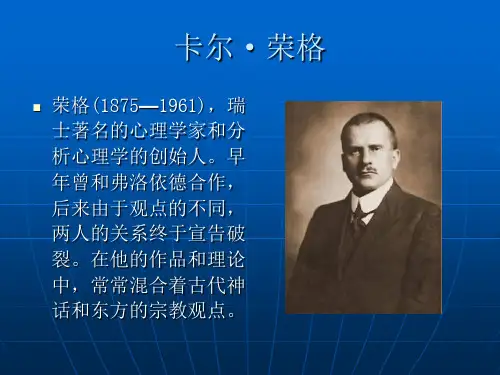
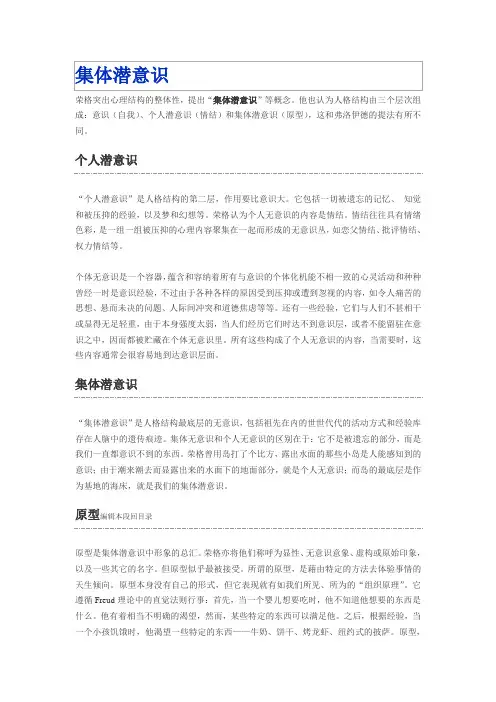
荣格突出心理结构的整体性,提出“集体潜意识”等概念。
他也认为人格结构由三个层次组成:意识(自我)、个人潜意识(情结)和集体潜意识(原型),这和弗洛伊德的提法有所不同。
个人潜意识“个人潜意识”是人格结构的第二层,作用要比意识大。
它包括一切被遗忘的记忆、知觉和被压抑的经验,以及梦和幻想等。
荣格认为个人无意识的内容是情结。
情结往往具有情绪色彩,是一组一组被压抑的心理内容聚集在一起而形成的无意识丛,如恋父情结、批评情结、权力情结等。
个体无意识是一个容器,蕴含和容纳着所有与意识的个体化机能不相一致的心灵活动和种种曾经一时是意识经验,不过由于各种各样的原因受到压抑或遭到忽视的内容,如令人痛苦的思想、悬而未决的问题、人际间冲突和道德焦虑等等。
还有一些经验,它们与人们不甚相干或显得无足轻重,由于本身强度太弱,当人们经历它们时达不到意识层,或者不能留驻在意识之中,因而都被贮藏在个体无意识里。
所有这些构成了个人无意识的内容,当需要时,这些内容通常会很容易地到达意识层面。
集体潜意识“集体潜意识”是人格结构最底层的无意识,包括祖先在内的世世代代的活动方式和经验库存在人脑中的遗传痕迹。
集体无意识和个人无意识的区别在于:它不是被遗忘的部分,而是我们一直都意识不到的东西。
荣格曾用岛打了个比方,露出水面的那些小岛是人能感知到的意识;由于潮来潮去而显露出来的水面下的地面部分,就是个人无意识;而岛的最底层是作为基地的海床,就是我们的集体潜意识。
原型编辑本段回目录原型是集体潜意识中形象的总汇。
荣格亦将他们称呼为显性、无意识意象、虚构或原始印象,以及一些其它的名字。
但原型似乎最被接受。
所谓的原型,是藉由特定的方法去体验事情的天生倾向。
原型本身没有自己的形式,但它表现就有如我们所见、所为的“组织原理”。
它遵循Freud理论中的直觉法则行事:首先,当一个婴儿想要吃时,他不知道他想要的东西是什么。
他有着相当不明确的渴望,然而,某些特定的东西可以满足他。
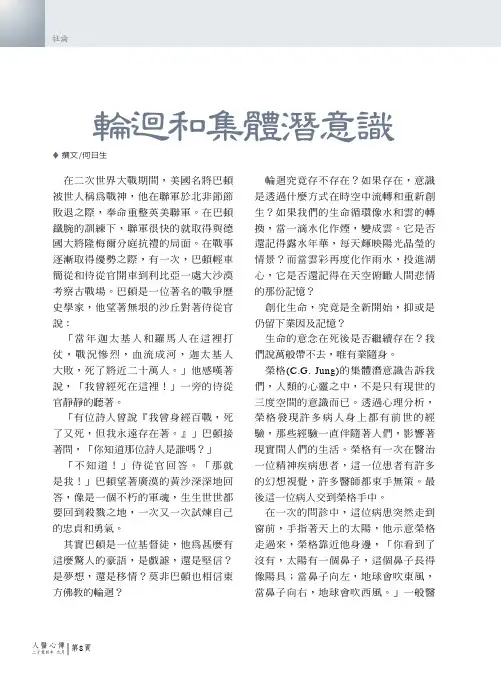
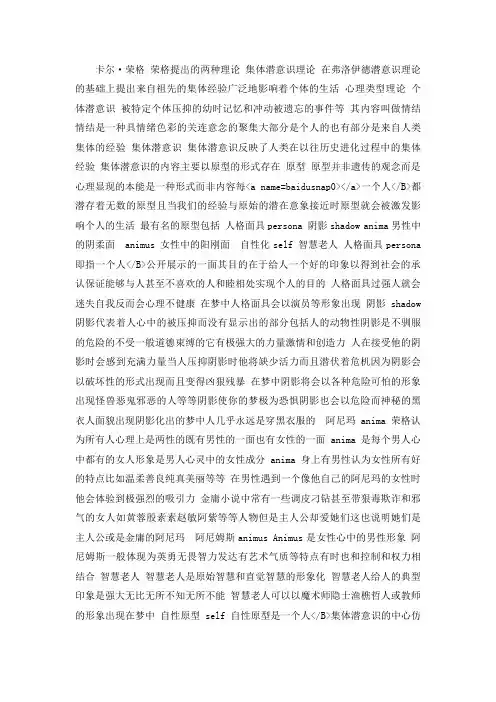
卡尔·荣格荣格提出的两种理论集体潜意识理论在弗洛伊德潜意识理论的基础上提出来自祖先的集体经验广泛地影响着个体的生活心理类型理论个体潜意识被特定个体压抑的幼时记忆和冲动被遗忘的事件等其内容叫做情结情结是一种具情绪色彩的关连意念的聚集大部分是个人的也有部分是来自人类集体的经验集体潜意识集体潜意识反映了人类在以往历史进化过程中的集体经验集体潜意识的内容主要以原型的形式存在原型原型并非遗传的观念而是心理显现的本能是一种形式而非内容每<a name=baidusnap0></a>一个人</B>都潜存着无数的原型且当我们的经验与原始的潜在意象接近时原型就会被激发影响个人的生活最有名的原型包括人格面具persona 阴影shadow anima男性中的阴柔面 animus 女性中的阳刚面自性化self 智慧老人人格面具persona 即指一个人</B>公开展示的一面其目的在于给人一个好的印象以得到社会的承认保证能够与人甚至不喜欢的人和睦相处实现个人的目的人格面具过强人就会迷失自我反而会心理不健康在梦中人格面具会以演员等形象出现阴影shadow 阴影代表着人心中的被压抑而没有显示出的部分包括人的动物性阴影是不驯服的危险的不受一般道德束缚的它有极强大的力量激情和创造力人在接受他的阴影时会感到充满力量当人压抑阴影时他将缺少活力而且潜伏着危机因为阴影会以破坏性的形式出现而且变得凶狠残暴在梦中阴影将会以各种危险可怕的形象出现怪兽恶鬼邪恶的人等等阴影使你的梦极为恐惧阴影也会以危险而神秘的黑衣人面貌出现阴影化出的梦中人几乎永远是穿黑衣服的阿尼玛anima 荣格认为所有人心理上是两性的既有男性的一面也有女性的一面 anima是每个男人心中都有的女人形象是男人心灵中的女性成分 anima身上有男性认为女性所有好的特点比如温柔善良纯真美丽等等在男性遇到一个像他自己的阿尼玛的女性时他会体验到极强烈的吸引力金庸小说中常有一些调皮刁钻甚至带狠毒欺诈和邪气的女人如黄蓉殷素素赵敏阿紫等等人物但是主人公却爱她们这也说明她们是主人公或是金庸的阿尼玛阿尼姆斯animus Animus是女性心中的男性形象阿尼姆斯一般体现为英勇无畏智力发达有艺术气质等特点有时也和控制和权力相结合智慧老人智慧老人是原始智慧和直觉智慧的形象化智慧老人给人的典型印象是强大无比无所不知无所不能智慧老人可以以魔术师隐士渔樵哲人或教师的形象出现在梦中自性原型self 自性原型是一个人</B>集体潜意识的中心仿佛太阳是太阳系的中心负责人格的统一组织和秩序梦中这一原型较少出现只有心理极健康心理发展很完善的人才能经常梦见这一原型有时梦中的自性原型以太阳的形象出现有时以佛菩萨的形象出现有时以一座庄严的神庙形象出现有时以类似曼荼罗的形象出现也有时以一种宝物如钻石或宝石的形象出现不论它以什么形象出现梦中都有一种安宁平静神圣的感受电影《功夫》的心理分析这部电影我们可以把它看成一个人</B>剧中出现的所有东西都是一个人</B>内部的东西剧中出现的事件是一个人</B>内部发生的事件故事发生在一个混乱的年代这个混乱的年代里黑帮统治了民生尤以斧头帮最为霸道他们烧杀抢掠无恶不作这样混乱的年代里唯有黑帮都没有兴趣的贫困社区猪笼城寨得以远离喧闹获得安宁猪笼城寨是一个健全的社区里面有以杨过小龙女为首的一些隐居的武林高手故事的中心人物周星驰儿时有一个奇特的经历他遇到了一个乞丐给他了一本如来神掌秘籍周星驰立志要学会绝世武功维护世界和平一次他见到了一群小混混欺负一个小女孩他勇敢地想用自己学习的武功去救小女孩但是失败了失败后遭到了小混混们的侮辱在小女孩表示自己的感谢递给他棒棒糖时他拒绝了长大以后周星驰便成了一个小混混他像没爹没娘的孩子一样在街头流浪一直想加入斧头帮扬名立万但却没有胆量做坏事每次做坏事都很失败周星驰到猪笼城寨敲诈不成却引起了猪笼城寨和斧头帮的大对决在对决中开始是杨过小龙女打败了杀手天残和地残随后会开锁的周星驰被斧头帮老大威逼利诱去一个秘密关押的地方释放了武林第一高手火云邪神杨过小龙女和火云邪神之间的大战爆发关键时刻已经是斧头帮成员的周星驰倒戈帮助杨过小龙女逃跑而自己被火云邪神打得不成人样奇迹发生了原来经过火云邪神的致命打击却鬼使神差的打通了周星驰的任督二脉周星驰终于掌握了儿时学习的如来神掌打败并接纳了火云邪神从而实现了自己儿时的梦想维护世界和平后来他愉快地和儿时的伙伴哑女相认《功夫》主人公的原型人格面具斧头帮帮主阴影火云邪神阿妮玛哑女智慧老人乞丐自性原型如来影片最后有一个场景此时周围的人物都一对一对的在一起聊天逛街彼此之间显得很和谐和开始的时候那种不和谐形成鲜明的对比看起来就像是这个世界都变了一样其实这是因为周星驰的内心世界变了他的周围的人物世界也就发生了变化也就是佛家讲的心生则种种法生经过了一番心灵蜕变周星驰的积极健康的爱心生出来了所以他的世界也变得很有爱心很和谐心理类型理论两个基本态度内向与外向四个独立的功能思维情感感觉以及直觉美国心理学家布里格斯和迈尔斯母女在荣格的基础上又增加了判断和知觉两种类型由此组成了个性的四维八极特征它们彼此结合就构成了十六种个性类型 MBTI 内倾I-- 外倾E维度我们与外界相互作用的程度以及自己的能量被引向何处外倾的人倾向于将注意力和精力投注在外部世界外在的人外在的物外在的环境等而内倾的人则相反较为关注自我的内部状况如内心情感思想感觉S-- 直觉N维度我们自然注意到的信息类型感觉型的人关注由感觉器官获取的具体信息看到的听到的闻到的尝到的触摸到的事物例如关注细节喜欢描述喜欢使用和琢磨已知的技能直觉型的人关注事物的整体和发展变化趋势灵感预测暗示重视推理例如重视想象力和独创力喜欢学习新技能但容易厌倦喜欢使用比喻跳跃性地展现事实思维T-- 情感F维度我们做决定和得出结论的方法情感型的人常从自我的价值观念对或错有意义或无意义出发变通地贯彻规章制度做出一些自己认定是对的决策比较关注决策可能给他人带来的情绪体验人情味较浓思维型的人则比较注重依据客观事实的分析一以贯之一视同仁地贯彻规章制度不太习惯根据人情因素变通哪怕做出的决定并不令人舒服判断J 知觉P 我们喜欢以一种较固定的方式生活或做决定还是以一种更自然的方式生活或获取信息判断型的人目的性较强他们喜欢有计划有条理的世界更愿意以比较有序的方式生活知觉型的人好奇心适宜性强他们会不断关注新的信息喜欢变化也会考虑许多可能的变化因素更愿意以比较灵活随意开放的方式生活感觉S 直觉N 思维T 情感F 判断J 知觉P 直觉思维概念主义者感觉知觉经验主义者直觉情感理想主义者感觉判断传统主义者概念主义者直觉思维概念主义者型的人自信有智慧富有想像力他们的原则是所有的事情都要做到最好概念主义者是四种类型中最独立的一种人他们工作原则性强标准高对自己和对别人的要求都很严格他们不会被别人的冷遇和批评干扰喜欢以自己的方式做事概念主义者型的人天生好奇无论是由于工作本身的需要还是出于长远的考虑他们很喜欢不断地吸取知识他们因此而常常看得到同一问题的多个不同的方面习惯于全面地概括地思考问题和一分为二地看待问题他们很善于发现事物的可能性理解事物的复杂性喜欢进行逻辑的分析从而对真实或假设的问题构思出解决方案概念主义者喜欢能够提供自由变化和需要有较高的智力才能完成的工作不喜欢简单重复的工作他们喜欢看到自己的想法能够得到实施概念主义者会对那些他们认为不够能干的人不耐烦喜欢与很有能力的上司下属同事共事许多概念主义者型的人推崇权力易于被有权力的人和权力地位所吸引优势 1 善于分析总结判断2 善于从整体上把握事物3 喜欢追根究底力图抓住事物的本质4 对文字语言敏感5 抽象思维能力强能理解复杂的理论概念善于将事情概念化善于从中推断出原则或预测趋势6 擅长策略性思维7 会接受建设性的批评而不把它当作针对个人的问题潜在的弱点 1 由于有时给自己定了不切实际的高标准可能对自己和他人的期望过高2 易于像紧逼自己工作一样去逼着别人工作3 常常不希望别人对抗自己的意愿有时给人顽固死板的印象4 易于过份强调工作从而损害了家庭的和谐5 常常不记得花时间夸奖同事下属或其他人经验主义者感觉知觉经验主义者是四种类型中最富冒险精神的他们最可贵的地方在于机智多谋令人兴奋而且很有趣他们为行动冲动和享受现在而活着一想到某件事情就有立即去做的冲动而且喜欢一气呵成一口气把事情做完但又不喜欢太长时间做同一件事情只有很少的事情如自己很喜欢的事情能够长期坚持多数情况下难以做到坚持不懈他们关注于眼前的情况对眼前的情况看得很清楚并能正确估计立即需要做什么他们崇尚自由和主动很少选择需要太多结构和规则的活动和环境他们适应能力强随遇而安而且注重实际经验主义者喜欢有技巧性的活动他们常常被认为是喜欢冒险喜欢寻找刺激的人优势 1 对人事物观察敏锐能够清楚地看到正在发生的事情而且能够敏捷地抓住机会2 思维及行动反应敏捷活跃擅长随机应变3 有创新意识不象传统主义者那样墨守成规4 许多经验主义者但不是全部尤为擅长使用工具和演奏乐器这些东西可以被他们实际操作而且要求有一定的精确度潜在的弱点 1 因为喜欢面对各种各样的可能性他们不能一直遵守已建立的规则有时会逃避约束或计划 2 他们有时会在没有认真考虑的情况下就行动 3 有创新意识不象传统主义者那样墨守成规 4 许多经验主义者但不是全部尤为擅长使用工具和演奏乐器这些东西可以被他们实际操作而且要求有一定的精确度理想主义者直觉情感理想主义者型的人感兴趣的是事物的意义关系和可能性并基于其个人的价值观念做出决定这是一类关心个人成长和如何理解他人与自我的人理想主义者做人的原则是真实地面对自已是四种类型中精神上最具哲理性的人理想主义者乐于接受新的思想善于容纳他人理想主义者好象永远在寻找生存的意义他们非常崇尚人与人之间和各种关系中的真实和正直容易将别人理想化许多理想主义者本能地喜欢帮助别人成长和进步理想主义者是很好的传播者被人们认为是促进积极变化的催化剂他们天生能够理解别人的情感关心他们在生活工作中碰到的人们如同事病人或客户雇员的需要对于理想主义者型的人而言一份好的工作应该是对他们个人很有意义的工作而不是简单的常规工作或只是一种谋生手段理想主义者崇尚和谐不愿意在一种竞争激烈或四分五裂的环境中发展他们喜欢民主能够激励各种层次的人们高度参与的组织他们会被那些促进人性价值的组织或那些允许他们帮助别人完成工作的职业所吸引优势 1 对别人的情绪敏感能理解体会别人的心情善于安慰鼓励别人2 对文字语言敏感3 善于分析总结4 善于从整体上把握事物5 能理解复杂的理论概念善于将事情概念化善于从中推断出原则6 擅长策略性思维潜在的弱点 1 有仅仅凭个人的好恶或价值观来决定事情并希望别人也以同样的角度或标准来处理问题的倾向2 有时他们心里老想着别人的问题可能会过于陷于其中以至于被其困扰3 有时容易将别人或事情理想化不够实际4 不是特别善于管束和批评他人尽管常常自我批评有时会为了和睦而牺牲自己的意见或利益5 有些理想主义者比较容易动感情情绪波动较大传统主义者感觉判断传统主义者是四种类型中最传统的一类他们坚定可靠可信他们重视法律秩序安全得体规则和本分他们被一种为社会服务的动机所驱使他们尊重权威等级制度和权力而且一般具有保守的价值观他们很有责任感而且经常努力去做正确的事情这使他们可以信赖和依靠传统主义者需要有归属感需要服务于别人需要做正确的事情他们注重安稳秩序合作前后一致和可靠而且他们严肃认真工作努力传统主义者在工作中对自己要求十分严格而且他们希望别人也是如此传统主义者喜欢那些与他们一样具有奉献精神尊重权威和尽自己的本分的同事优势 1 实际有条理认真仔细2 注重规则政策契约例行习惯和时间要求3 一旦他们承诺一件事情总会坚持完成它4 在跟进规范方面做得很好5 以第一次和每一次都做了正确的事情为荣6 对需要注意的事情有敏锐的洞察力7 善于尽可能有效地利用现有资源完成工作潜在的弱点 1 容易只看到事情有黑和白两种情况而看不到中间的灰色地带 2 可能不能很快地做出改变和适应3 有些传统主义者不擅长变通缺乏想象力健康人格指针自我实现self-realization亦即心理的重生或自性化individuation 将个人内在各种对立面加以统合而成为单一同质的个体的历程自我实现者的特征在实现个人时persona的影响已减至最低对于个人的anima或animus已有意识上的觉察内外向态度之间以达到相当的平衡操弄四种功能到优势位置荣格认为只有那些能将他们的潜意识同化而成整体的人格的人才能达到自我实现事实上很少人能达此境界自我实现的人必须有勇气面对自己阴影中的邪恶本质而且要有更大的力量去接受自己内在的男性或女性面中年其以后才有可能迈克尔·乔丹玛丽琏·梦露代表人物列宁甘地代表人物乔治·布什代表人物阿星的人格面具黑帮帮主阿星的阴影火云邪神阿星的阿尼玛哑女与阿尼玛情感交流排斥阿尼玛阿尼玛的支持力量整合阿尼玛阿星的自性原型如来降伏阴影想学吗我教你啊包裹地象一只蛹化蛹成蝶阿星的智慧老人乞丐内倾外倾感觉直觉思维情感判断知觉 MBTI 与他人在一起时感到振奋独自一人时感到振奋希望成为注意的焦点避免成为注意的焦点先行动再思考先思考再行动喜欢边想边说出声在脑中思考易于被了解愿与人共享个人信息注重隐私只与少数人共享个人信息说的比听的多听的比说的多热情地交流不把热情表现出来反应迅速喜欢快节奏思考之后再反映喜欢慢节奏较之精深更喜欢广博较之广博更喜欢精深外向 E 内向I 测测你的性格类型相信确定而有形的事物相信灵感和推理喜欢具有实际意思的新主意喜欢新主意和新概念只出于自己崇尚现实主义与常识崇尚想象力和新事物喜欢运用和琢磨已有的技能喜欢学习新技能但掌握后又厌倦留心特殊的和具体的喜欢给出细节留心普遍和有象征的使用隐喻循序渐进的给出信息跳跃式的以一种绕圈的方式给出信息着眼于现在着眼于将来测测你的性格类型后退一步客观的分析问题向前看关心行动给他人带来的影响崇尚逻辑公正和公平有统一的标准注重感情与和睦看到规则的例外性自然地发现缺点有吹毛求疵的倾向自然地想让别人快乐易于理解别人可能被视为无情麻木漠不关心可能被视为过于感情化无逻辑脆弱认为诚实比机敏更重要认为诚实与机敏同样重要认为只有合乎逻辑的感情才是正确的认为所有感情都是正确的不管意义受获得成就欲望的驱使受被人理解的愿望的驱使测测你的性格类型做完决定后感到快乐因保留选择的余地而快乐具有工作原则先工作后玩具有玩的原则先玩再工作确定目标并按时完成任务当有新的情况时便改变目标想知道自己的处境喜欢适应新环境着重结果着重过程通过完成任务获得满足通过着手新事物而获得满足把时间看成有限的资源把时间看成无限的资源测测你的性格类型 MBTI性格类型与职业选择要求具有适应新环境能力的工作需要新的创新性头脑的任务知觉型具有高度组织性和结构性的工作在新任务开始前能完成的任务判断型具有挑战性非重复性的任务靠洞察力和沉思来解决的抽象问题直觉型要求注意细节的工作短期的有形的目标直接或与目标直接相关的工作感觉型服务性工作特别是向普通平民提供服务的工作满足个人需要的工作情感型需要解决大量问题特别是需要逻辑推理的工作与数字有关有明确解决方案的工作思维型安静的独自进行的文案工作很少被打扰要求集中注意和思考的内向型要求群体交往与人会谈社交聚会有大量的旅行讲话和变化外向型职业类型不同性格类型的理想职业代表人物荣格的分析心理学荣格 18751961 瑞士著名的心理学家和分析心理学的创始人早年曾和弗洛依德合作后来由于观点的不同两人的关系终于宣告破裂在他的作品和理论中常常混合着古代神话和东方的宗教观点意识个体潜意识集体潜意识人类心灵的层次人类的进化历程围城中的唐晓芙ISTJInspector稽查员ISFJProtector保护者INFJCounselor咨询师INFPHealerTutor治疗师导师ESTJSupervisor督导ESFJProviderSeller供给者销售员ENFJTeacher教师ENFPChampionAdvocate Motivator倡导者激发者ISTPOperatorInstrumentor操作者演奏者ISFPComposerArtist作曲家艺术家INTJMastermindScientist智多星科学家INTPArchitectDesigner建筑师设计师ESTPPromotor发起者创设者ESFP Performer Demonstrator表演者示范者ENTJ Field Marshall Mobilizer统帅调度者ENTP Invertor发明家。
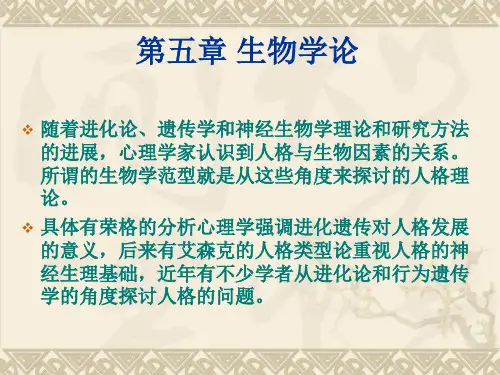
人格结构的相互作用是一个复杂的过程,涉及到多个心理要素之间的相互影响。
荣格认为人格是一个相互作用的结构,它包括意识、个体潜意识和集体潜意识。
1. 意识:指的是个人当前所觉知的一切,包括知觉、思维、感受等。
它是人格结构的最表层,能够被直接感知和表达。
2. 个体潜意识:指的是那些被遗忘或被压抑的记忆、经验、欲望等,它们在个体成长过程中形成,对个人行为和思维产生影响。
个体潜意识是荣格人格理论的重要组成部分,它能够揭示个体的内在冲突和动机。
3. 集体潜意识:指的是人类在历史长河中积累下来的集体经验和记忆,它存在于每个人的内心深处,是人格结构的最底层。
集体潜意识对个人的认知、情感和行为产生深刻影响,它是荣格理论中最为神秘和抽象的概念之一。
在人格结构的相互作用中,个体潜意识和集体潜意识相互作用,影响着个体的认知、情感和行为。
意识则将这些心理要素整合在一起,形成一个完整的人格。
当自我与阴影相互配合、亲密和谐时,人就会感到自己充满了生命的活力。
反之,排斥和压倒阴影会使一个人的人格变得平庸苍白。
以上内容仅供参考,建议查阅专业心理学书籍获取更全面和准确的信息。
[杂感篇275]集体潜意识(一)手边搁置很久的一册荣格的《心理类型》,昨天终于翻看第一章。
一章就有52页,理论性强,有点不好读。
想到了标题的这个名词,就是荣格分析心理学的一个关键词。
读不快,先开个头。
想通过心理学的阅读思考,更好理解这个A股里的大众交易心理,改善自己的交易心态。
一般,理论性的书籍,至少复读两遍,也仅能大概明白作者的思想。
心理学家,是喜欢思索无意识和人生种种神秘现象的一群人。
荣格称:“我的一生是无意识自我实现的历程”。
人类千奇百怪的神秘现象,在股市里比比皆是。
以下是阅读中散碎的相关随笔。
贪婪或恐惧,是人性之一,也会转化为心理能量。
社会活动中的一种心理沉淀是集体无意识,支配和规范着人的精神活动,使人无法超越和摆脱。
心理学有显意和隐意、意识和无意识等概念,A股的猴性、炒作题材的疯狂,是市场的一种集体无意识,要从心理学角度进行理解和思考,仅局部于理性是不能全面解释的,与股市的历史文化有关。
散户们是这个历史文化的携带者。
1,我们能够看到色彩,但看不到波长,于是每个人之间,出现了看法的差异。
每个人都是从自己出发,看到了最易看到的东西。
于是,每个人都坚持自己的看法是对的。
能看清自己身上的大缺陷,太难了,即人是难以做到客观的,无法做到纯粹客观。
(做股票同样如此,不断的去伪存真,不能教条,不能迷信,逻辑的客观性是有限的)。
2,要摆脱集体观念和集体情感的强制性影响,获得对自己个性的清晰概念,才能完全了解你自己。
否则,个性泯灭在集体主义的外表之下,人不自觉在陷入到集体潜意识之中(在股市里,盲目跟风炒作,弱手最容易被强手放在高位站岗)。
3,人的天性之一,人会本能地在自然的过程之中,依循最小阻抗的原则。
人不能适应市场之心的时候,是人单一性的态度,即心理的缺陷所引起的,人要自我救赎(既要善于思考自身,又要善于观察市场,两方面不可偏废)。
4,认为理念是具有永恒不变的有效性,是唯实论。
认为要从现实观点出发,概念是无用的,是唯名论。
让你变强的心理学,荣格靠它建立了集体潜意识理论……欢迎来到:自说自话的总裁前面我们聊了荣格与吕洞宾的故事。
我们说到,吕洞宾的纯阳学说(《太乙精华宗旨》)让荣格摆脱了梦境,找到了方向。
然后,荣格靠东方哲学的启发,最终建立了自己的心理学理论,这就包括集体潜意识、共时性等等。
在荣格建立这些理论的过程中,除了道家学说,还有一本东方典籍对他的影响非常大。
这本书叫做《西藏度亡经》(Bar-do thos-grol)。
荣格说它是“伟大的心理学的真理”,还说,这本书一直是自己常年不变的伴侣,自己从中得到了很多知识和点拨,而且就连很多根本性的洞见也来源于这本书。
今天,我们就来聊聊这本书。
故事从一个西藏寓言说起。
人死之后人死以后,你会在一片光明中醒来。
这个时候,你意识不到自己已经死了。
然后,谁把灯关了。
你掉到一片黑暗当中。
接着,一个非常恐怖的魔鬼会出现在你面前。
这个时候,你有两个选择:1,面对2,逃跑如果你选择逃跑,你就会经历一场惊心动魄的大逃杀。
但最终,你会摆脱魔鬼,获得自由。
但过不了几分钟,你就会掉到另一片黑暗当中,第二个魔鬼出现。
这个魔鬼并没有第一个魔鬼恐怖。
这个时候,你依旧有两个选择:1,面对2,逃跑如果你还选择逃跑,你还是能成功摆脱魔鬼,但马上就会遇到下一个魔鬼。
你每逃跑一次,魔鬼就变得不那么恐怖一点。
所以,这个过程中,一共有三种情况。
第一种情况,你每一次都逃跑了,那么你转世以后将成为最低级的生命。
第二种情况,你在某一次逃跑后,选择了面对魔鬼,那么后面出现的魔鬼将越来越可怕,你转世以后也将成为更高级的生命。
第三种情况,如果第一个最恐怖的魔鬼出现时,你都没有逃跑,接着就会发生两件事儿。
第一件事,你会发现,这个魔鬼原来是你的幻觉,无论它多么恐怖,根本伤不了你,你们就不是一个次元的。
所有的恐怖都是你想象出来的。
第二件事,当你看透魔鬼的把戏后,你就可以不再经历六道轮回,可以进入极乐世界了。
《西藏度亡经》这个寓言故事,其实就是《西藏度亡经》这本书的核心内容。
集体潜意识、叙述重构、认知失调、阿伦森效应所谓集体潜意识理论,就是说,在漫长的历史演化过程中世代积累的人类祖先的经验,会以原始意象的形式保持和遗传下来。
叙述重构:为了使自己的话显得可信,下意识地虚构某些记忆。
认知失调人类普遍都有一种需求,那就是追求认知和行为的平衡协调,一旦失调就会造成心理紧张而感到不舒服,并促使人去减少认知失调。
当一个人面对新情境需要表态时,心理上可能会出现新的理解和大脑中已有观念发生冲突的情况,这时候体会到的心理矛盾状态就是认知失调。
为了消除这种不舒适的失调,我们可以采用两种办法自我调适:一是否认新的认知,也就是说拒绝与自己原来信念不一致的新观点,这样就不用改变自己原来的认知了,也就恢复了心理平衡;二是寻找更多关于新认知的信息,直到自己掌握足够的信息可以说服自己,看来事实真的是这样,然后放弃自己原有的观点,达到心理平衡。
这项实验是他和卡尔史密斯一同主持的。
如同其他精明的社会心理学家一样,他们也精心设计了实验,就等着被试乖乖“上钩”。
首先,他们要求被试做一件很无聊的工作,例如不断地重复进行计算,或者抄写数字。
这一枯燥乏味的过程结束后,被试被要求告诉其他人这个工作很有趣,值得花费大量的时间。
在这些被试中有些获得了1美元的报酬,有些则幸运地拿到了20美元!实验结束后,他们会接受采访,询问内心对这件工作趣味性的真实想法。
研究结果真是万万想不到,相比于拿20美元的人,拿到1美元报酬的人中,竟然有较多人认为这无聊的工作真的很好玩。
费斯廷格如此解释:拿到20美元的人认为这20 美元足以让自己撒个谎告诉别人这是很有趣的工作,因而他们并不会尝试去改变内在的认知(这工作本来就很无聊);而得到1 美元的人想的是为了1美元就出卖自己的真诚实在太廉价了,这肯定是不行的,因此当他们告诉别人这个工作有趣时,他们只能让自己相信这真的很有趣,才能减少认知失调的压力。
如今,不仅是心理学学术领域,在我们日常的生活中,在电视、报纸和网络。
提出集体潜意识这个概念的是( ) 提出集体潜意识这个概念的是荣格,卡尔·荣格(Carl Gustav Jung,1875到1961),瑞士心理学家。
1907年开始与西格蒙德·弗洛伊德合作,发展及推广精神分析学说长达6年之久,之后与弗洛伊德理念不和,分道扬镳,创立了荣格人格分析心理学理论,出“情结”的概念,把人格分为内倾和外倾两种,主张把人格分为意识、个人无意识和集体无意识三层。
曾任国际心理分析学会会长、国际心理治疗协会主席等,创立了荣格心理学学院。
1961年6月6日逝于瑞士。
他的理论和思想至今仍对心理学研究产生深远影响。
集体潜意识又译作“集体无意识”,是荣格分析心理学术语。
指人类祖先进化过程中,集体经验心灵底层的精神沉积物,处于人类精神的最低层,为人类所普遍拥有。
在个体一生中从未被意识到,经由遗传获得来。
由全部本能及其相关的原型组成。
本能体现精神的动力方面,原型体现本能的意义,是本能在人精神中的存在形式,决定人的行为的未来倾向和可能性两者协调一致。
具有先验性、普遍性、自主性、自律性、动力性和目的性等,是人类精神中最重要和最有影响的部分,对个体的思想行为和创造力起制约作用。
虽处于潜意识的最低层,但无时不在寻求表现,若其内容未被意识同化,则会通过宗教、神话、艺术、梦幻和象征等表现出来。